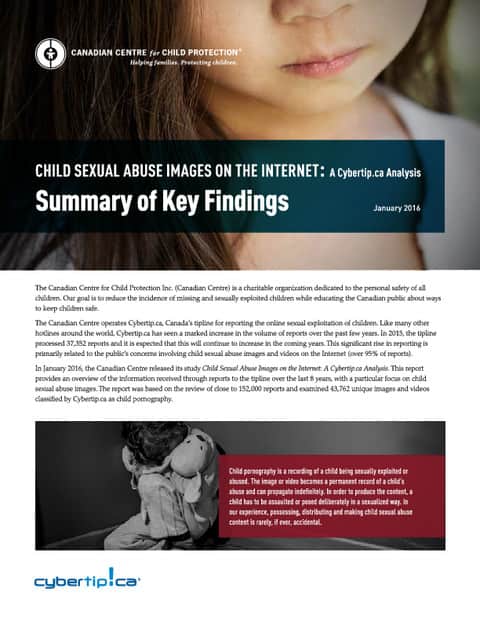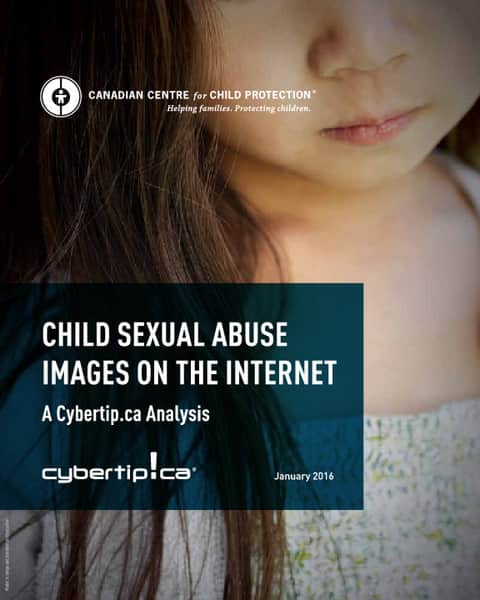The harsh reality is 78% of the images and videos analyzed by Cybertip.ca depict children under 12, with the majority (63%) of those being under 8 years of age.
Child Sexual Abuse Images on the Internet: A Cybertip.ca Analysis
Child Sexual Abuse Images on the Internet: A Cybertip.ca Analysis was based on the review of close to 152,000 reports and examined 43,762 unique images and videos classified by Cybertip.ca as child sexual abuse material.
This 2016 report highlights the serious prevalence of child sexual abuse material on the internet and the need for more to be done to identify the children portrayed in the images and videos, stop offenders, and reduce the availability and continued distribution of this content.
In the analyzed images, as the age of the children decreases, the sexual abuse and sexual exploitation acts become more intrusive.
Summary of Key Findings
Key findings from Child Sexual Abuse Images on the Internet: A Cybertip.ca Analysis include:
- 78% of the images and videos assessed depicted very young, prepubescent children under 12 years old.
- 63% of those children under 12 years old appeared to be under 8 years of age.
- 7% of those children under 8 years old appeared to be babies or toddlers.
- 80% of the children were girls.
- 77% of the children’s faces were visible in the images and videos.
- 50% of the images and videos involved explicit sexual activity/assaults and extreme sexual assaults.
- 54% of the abuse acts against children under 12 years old involved explicit sexual activity/assaults and extreme sexual assaults.
- 60% of the abuse acts against babies and toddlers involved explicit sexual activity/assaults and extreme sexual assaults.
- 69% of the images and videos appeared to be in a home setting, of which 70% captured explicit sexual activity/assaults and extreme sexual assaults.
- 83% of the adults visible in the images and videos were males.
- 97% of the content involved explicit sexual activity/assaults and extreme sexual assaults when adult males were visible with the children in the images and video.
Learn More About Report Findings
Recommendations for Change
The findings in the report underscored that more needs to be done to identify and support survivors of child sexual abuse, and as such, C3P provided several recommendations to strengthen our commitment to fighting the exploitation and sexual abuse of children:
- Identify and rescue more victims in child sexual abuse material by working closely with child exploitation units, and improve support services in Canada to better protect the rights of victims when abuse material is circulating online.
- Reduce the availability of child sexual abuse material to Canadians by leveraging technology to disrupt the growing problem of sexual abuse material online, strengthening private sector involvement, and strengthening Canada’s role internationally.
- Increase reporting by Canadians through national public awareness campaigns and working with relevant stakeholders to promote reporting.
- Stop offenders by enhancing resources and training in Canada including increased police and forensic capacity, adopting best practices related to reducing online sexual exploitation of children, and adapting the Criminal Code and related legislation to aid in the tackling of this problem.
- Focus efforts on prevention and education using recognized prevention programming in addition to the creation of new resources for parents, health care professionals, and public facilities (e.g., pools).
Action Taken
Since the release of Child Sexual Abuse Images on the Internet: A Cybertip.ca Analysis in 2016, C3P has developed several initiatives in response to the recommendations in the report:
- International Survivors’ Survey and developing survivor network — Learn more about this survivor-centric initiative developed by C3P.
- Project Arachnid — Learn how C3P is using technology to combat child sexual abuse material on the internet.
- Protecting Children in Public Spaces — Learn more about a multiphase initiative between C3P and City of Winnipeg to enhance children’s safety at aquatic, leisure, and library facilities.

